
Henry Walter Bates was an English naturalist and explorer who gave the first scientific account of mimicry in animals. He was most famous for his expedition to the rainforests of the Amazon with Alfred Russel Wallace, starting in 1848. Wallace returned in 1852, but lost his collection on the return voyage when his ship caught fire. When Bates arrived home in 1859 after a full eleven years, he had sent back over 14,712 species of which 8,000 were new to science. Bates wrote up his findings in his best-known work, The Naturalist on the River Amazons.

In evolutionary biology, mimicry is an evolved resemblance between an organism and another object, often an organism of another species. Mimicry may evolve between different species, or between individuals of the same species. In the simplest case, as in Batesian mimicry, a mimic resembles a model, so as to deceive a dupe, all three being of different species. A Batesian mimic, such as a hoverfly, is harmless, while its model, such as a wasp, is harmful, and is avoided by the dupe, such as an insect-eating bird. Birds hunt by sight, so the mimicry in that case is visual, but in other cases mimicry may make use of any of the senses. Most types of mimicry, including Batesian, are deceptive, as the mimics are not harmful, but Müllerian mimicry, where different harmful species resemble each other, is honest, as when species of wasps and of bees all have genuinely aposematic warning coloration. More complex types may be bipolar, involving only two species, such as when the model and the dupe are the same; this occurs for example in aggressive mimicry, where a predator in wolf-in-sheep's-clothing style resembles its prey, allowing it to hunt undetected. Mimicry is not limited to animals; in Pouyannian mimicry, an orchid flower is the mimic, resembling a female bee, its model; the dupe is the male bee of the same species, which tries to copulate with the flower, enabling it to transfer pollen, so the mimicry is again bipolar. In automimicry, another bipolar system, model and mimic are the same, as when blue lycaenid butterflies have 'tails' or eyespots on their wings that mimic their own heads, misdirecting predator dupes to strike harmlessly. Many other types of mimicry exist.

Dismorphiinae, the mimic sulphurs, is a subfamily of butterflies from the family Pieridae. It consists of about 100 species in seven genera, distributed mainly in the Neotropical region, of which only one species occurs in North America and one genus, Leptidea, is in the Palaeartic region.

Dismorphia is a genus of butterflies in the subfamily Dismorphiinae.

Dismorphia amphione, the tiger mimic white, is a species of butterfly of the family Pieridae. It is found from Mexico and the Caribbean down to Brazil and Bolivia.

Dismorphia theucharila, the clearwinged mimic white, is a species of butterfly of the family Pieridae. It is found from Mexico to Bolivia and the Guianas.

Lieinix nemesis, the frosted mimic-white, nemesis mimic white or falcate dismorphia, is a butterfly in the family Pieridae. It is found from Mexico to Peru. The habitat consists of mid-elevation cloudforests.

Dismorphia mirandola is a butterfly in the family Pieridae. It is found in Ecuador and Colombia.
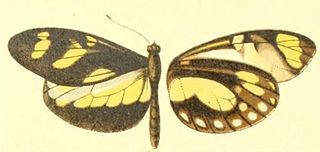
Dismorphia laja is a butterfly in the family Pieridae. It is found in northern South America.

Dismorphia zaela, the zaela mimic white, is a butterfly in the family Pieridae. It is found from Costa Rica to Ecuador.

Dismorphia medora, the Medora mimic white is a butterfly in the family Pieridae. It is found in Colombia, Ecuador and Peru.
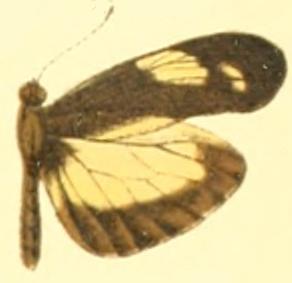
Dismorphia zathoe, the zathoe mimic white is a butterfly in the family Pieridae. The species was first described by William Chapman Hewitson in 1858. It is found in Central America and northern South America.
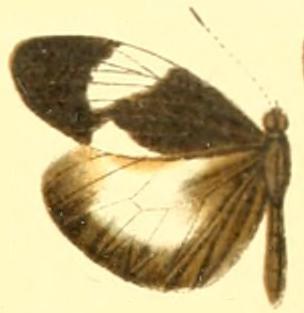
Dismorphia lysis, the dainty egg white or Lysis mimic white, is a butterfly in the family Pieridae. It is found from Ecuador to southern Peru. The habitat consists of cloud forests.
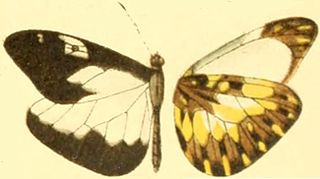
Dismorphia lygdamis, the catasticta mimic or Lygdamis mimic white, is a butterfly in the family Pieridae. It is found in Ecuador and Peru. The habitat consists of cloud forests.

Dismorphia crisia, the crisia mimic white or cloud forest mimic-white, is a butterfly in the family Pieridae. The species was first described by Dru Drury in 1782. It is found from northern Central America to Bolivia and the Amazon basin.

Dismorphia eunoe, the Eunoe mimic-white, is a butterfly in the family Pieridae. It is found from Mexico to Central America.
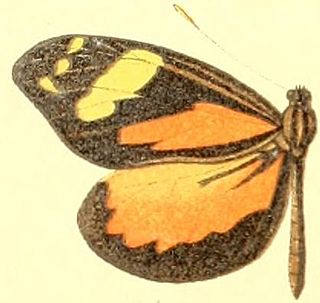
Dismorphia cubana, the Cuban dismorphia, is a butterfly in the family Pieridae. It is endemic to Cuba.
Dismorphia hyposticta is a butterfly in the family Pieridae. It is found in Ecuador, Venezuela, Colombia and Peru.

Dismorphia lelex, the lelex mimic white, is a butterfly in the family Pieridae. It is found in Ecuador and Colombia.

Dismorphia thermesia, the pretty mimic white, is a butterfly in the family Pieridae. It is found in Guyana, Brazil, Ecuador, Peru, and western Bolivia. The habitat consists of transitional rainforests and cloudforests.


















